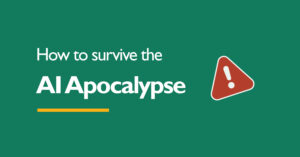Here’s an open secret: you can’t freestyle to a top creator position. Without a content calendar, you’ll keep running in circles with your content production processes and burn yourself out.
Everywhere you turn, someone is starting a blog, growing a YouTube channel, sharing daily TikToks, or posturing as a thought leader on LinkedIn.
Let’s be honest; it’s not stopping anytime soon.
Maybe you’ve caught the content bug, too, and strive to be like your favorite creator, consistently posting engaging and thoughtful content.
In this article, I’ll show you how to create a content calendar for your marketing efforts.
What is a content calendar?
A content calendar (also called an editorial calendar) is a written schedule of when and where you’ll publish upcoming content. Think of it as a roadmap for planning, managing, and organizing your content pre and post-production processes.
Typically, a content calendar includes:
- Content topics
- Formats (blog posts, emails, social media, videos, etc)
- Publication dates and platform
- Team members and contributors
- Statuses and creative assets
Curate your content calendar using a simple tool like Google Sheets or a more specialized tool like Trello or Notion. Choose whichever works best for you and your workflow.
Below is a basic example of a content calendar:
Why do you need a content calendar?
A lot of work goes into creating a single piece of content: research, planning, writing, editing, publishing, promotions, and more.
This process can be overwhelming and frustrating, especially if you’re a lone wolf handling everything yourself.
Even for teams, managing content production without a structured plan can lead to lost ideas, missed deadlines, and inconsistent posting.
A content calendar can help smoothen your workflow and offer a more rewarding process. It allows you to:
- Plan and avoid last-minute scrambling,
- Maintain consistency across different platforms,
- Align content with marketing campaigns and key events,
- Improve team collaboration and accountability,
- Track performance and make data-driven adjustments.
With such a solid system, you (or your team) can foster creative ideas in an organized, scalable manner.
What should a content calendar contain?
You have the autonomy to define and include what you deem essential to your calendar. However, the more details you provide, the better your workflow will be.
Here are some elements a content calendar should include:
#1: Content ideas
Every great piece of content starts with an idea. Your calendar should capture your content ideas to ensure you always have a backlog of ready-to-go content.
You can use research tools to get content ideas, share helpful personal experiences, follow trending topics, explore discussions on platforms like Quora and Reddit, or even answer questions people ask about your product.
Take advantage of every opportunity that comes your way, and note down those useful, random ideas that pop up in your head.
#2: Content formats and channels
No two pieces of content are the same.
That’s why you must specify whether a piece will be a blog post, a social media update, an email newsletter, a podcast, or a video. Also, specify which channels you’ll distribute each piece—your website, Instagram, LinkedIn, YouTube, or TikTok.
#3: Publishing schedule and deadlines
A well-planned publishing schedule helps you maintain a consistent posting rhythm and ensures you meet deadlines. This section should include specific publication dates for different content types across multiple platforms.
#4: Promotion and distribution plan
Content production doesn’t end with publishing; there are also post-publication processes, which involve promoting content to reach the target audience.
Plan and organize how you’ll distribute each piece across platforms, whether through organic social media posts, email campaigns, paid ads, or influencer collaborations.
#5: Content status and updates
Use status indicators like “Idea,” “In Progress,” “Under Review,” “Scheduled,” and “Published” so you know what stage a piece is in at any given moment.
This way, each assigned person can jump in when it’s their turn, and your marketing team will know when content is ready to be promoted.
#6: Links and keywords
Search engine optimization (SEO) is a critical aspect of content strategy for increasing visibility and driving organic traffic to your website. Your calendar should track target keywords, meta descriptions, and internal linking strategy.
This ensures that each piece of content aligns with search trends and is well-optimized for visibility on search engines and social platforms.
#7: Content ownership
If you’re working with a team, you must assign responsibilities for each content creation stage—writing, editing, designing visuals, scheduling, and promoting.
Make sure every team member clearly understands their role as well as who is in charge of approvals and sign-offs. This will leave an accountability paper trail for the team.
#8: Performance tracking
Your content strategy should be dynamic and not rigid. Track engagement metrics, website traffic, social shares, and conversions to see what’s working and adjust your approach accordingly.
Benefits of using a content calendar
While a content calendar won’t replace your content strategy, it helps keep your ideas organized and focused on your strategy, ensuring every post you share has a clear purpose. Let’s look at all the benefits in detail:
Helps visualize your content strategy
A content calendar gives a comprehensive view of your strategy, including the topics you’ll cover, your deadlines, content formats, keywords, and who’s in charge of what. It visualizes everything and helps you organize your strategy into weekly, monthly, or yearly blocks.
Imagine you manage a social media account and want to post eight videos in the coming weeks. Preparing a video involves many steps, such as preparing the script, recording, editing, and captioning.
With a content calendar, you can set schedules to finish these tasks in time and post them on the desired date.
Saves time, reduces stress, and brings consistency
It’s easy to get lost in the content creation process. You’re doing everything at once and paying less attention to the most important things, thinking you have a “working” strategy—one lapse and it’ll come crumbling.
Instead, planning your content calendar (short-term or long-term) keeps you organized and on top of your strategies. This eliminates the struggle of thinking about what to post next, when, and where.
With a solid schedule, you can establish a routine for your content production and achieve consistency throughout your processes.
Gives you a competitive advantage
Planning with a content calendar gives you ample time and clarity to create well-thought-out, targeted content for marketing.
Instead of freestyling, you create with intent, boosting efficiency and creating opportunities to differentiate your brand. Also, when new trends arise, you can be flexible and ready to capitalize on them ahead of your competitors.
And, of course, consistency builds anticipation among your audience. When your followers know when to expect your content, they’re more likely to engage with it. Over time, consistency strengthens your brand’s credibility and gives you an edge over competitors.
Increases transparency and collaboration
Content production usually involves multiple people and cross-department collaboration. A content calendar allows everyone to see who is responsible for what.
Writers, editors, designers, and content managers can monitor production and see what’s coming down the pipeline. This helps prevent confusion, missed tasks, and finger-pointing.
Everyone knows what the process expects of them and when to make the entire workflow smoother and more efficient.
Helps track engagement and measure ROI
You can easily track metrics like page views, social media followers, email sign-ups, or any other essential metrics by logging them into your calendar. This way, you can identify specific promotions or campaigns that drive the most engagement and deliver the best ROI.
How to create a content calendar
When creating a content calendar, you must first define your content marketing goals and objectives. Determine what you want to achieve with your content, then follow these steps:
1. Choose a tool
Before mapping out your processes, you need to choose a tool that makes them smooth and stress-free. Go for a tool that’s easy to use and fits seamlessly into your workflow.
There are many tools to choose from, including Google Sheets, CoSchedule, Trello, Notion, etc. Take your time to do thorough research, weigh the pros and cons, and then make a choice.
Don’t stress too much about making the perfect choice; you can always switch platforms later if you find one with better features.
2. Set a time frame
Determine how far ahead you want to plan your content. Some businesses like to map out things for a year, while others prefer to keep it flexible with a monthly or quarterly approach.
Your ideal time frame depends on your workflow, the speed of your industry, and your need for flexibility.
But if you’re just starting, planning monthly or quarterly might be the best approach. This gives you enough time to conduct research for more detailed content while staying organized.
3. Specify your marketing channels
You must specify what marketing channels you will distribute your content through. Remember that your marketing channels will determine your content’s format, tone, frequency, and engagement strategy.
So, tailor your content to fit each platform—an SEO article for your website won’t perform the same way on a heavily visual platform like Instagram.
Your content calendar can help you maintain a consistent and balanced publishing schedule across all your channels. It also ensures that you don’t overload specific channels and neglect others.
4. Determine content topics
You need to know and document what you’ll be creating. Don’t guess your way forward; stick to subjects that are relevant to your audience and align with your brand identity.
A good approach to this is to ask the following questions:
- What are my audience’s problems?
- What questions do they frequently ask?
- What trends or seasonal topics relate to my industry?
Assuming you run a fashion brand, your content will revolve around clothes, shoes, jewelry, makeup, and the rest.
So, obviously, your content topics will include style tips, product launches, behind-the-scenes content, and customer-generated content.
5. Record notable events
This is an important aspect of building a content calendar, if not for anything else, because it helps you keep track of key dates that could impact your audience’s interest and engagement.
You might not create content about each holiday or event, but knowing them helps you intentionally plan your posting schedules.
Be sure to note any:
- National holidays
- Awareness days (World Mental Health Day, International Women’s Day, etc.)
- Peak buying seasons (e.g., black Friday)
- Company events (product launches, webinars, etc.)
6. Decide on a posting schedule
How often can you realistically post content? The answer is “as frequently as necessary to keep your audience engaged.”
Assign a publication date and time for each post. If you’re sharing on multiple platforms, plan accordingly.
You can also research when to post on each of your desired platforms. According to Hubspot’s 2025 State of Marketing Report, most brands post content on social media at least four times weekly.
The report also shows that Tuesdays, Wednesdays, and Thursdays are best for engagement, while 6 to 9 p.m. is the optimal posting time.
I recommend experimenting with different schedules and posting frequencies to see what works for you and what doesn’t.
7. Review and adjust
It’s a good idea to check your content calendar regularly.
Does it still align with your business goals? Have your priorities shifted? Are there new topics that’ll better engage your audience?
Or maybe you’ve noticed certain types of content getting more traction than others.
Don’t be afraid to shuffle things. If something isn’t working, change it. If there are new opportunities, capitalize on them. Your content calendar is a part of your content strategy and should grow with your business.
Final words
As you’ve read, content creation requires careful planning, execution, and consistency to succeed. A well-implemented content calendar can be the backbone of this process.
To maximize your content calendar, you’ll need solid planning and reliable systems. Review and adjust your calendar regularly to reflect changes in your objectives and consumer behaviors.
Most importantly, consistently engage with your audience and streamline your content to their needs. Nail these steps, and you’re on your way to becoming the creator you admire.
Need help creating and working on your content calendar? Contact us right away.
Who wrote this?
Joanna is a versatile content writer with a knack for creating helpful content that resonates with others. When she’s not typing away, she finds solace in quiet moments, music, and cinematography videos. She believes she has an untapped well of creativity inside her and she’s willing to dig deep to fetch it out.
- Joanna Alihttps://roninpoint.com/author/joanna/
- Joanna Alihttps://roninpoint.com/author/joanna/
- Joanna Alihttps://roninpoint.com/author/joanna/
- Joanna Alihttps://roninpoint.com/author/joanna/April 20, 2025









